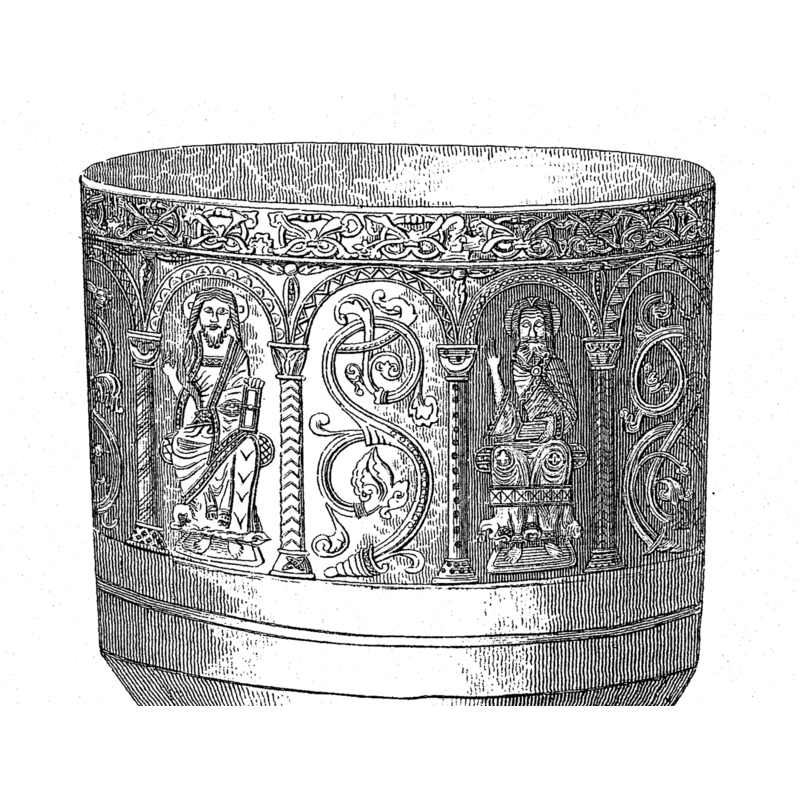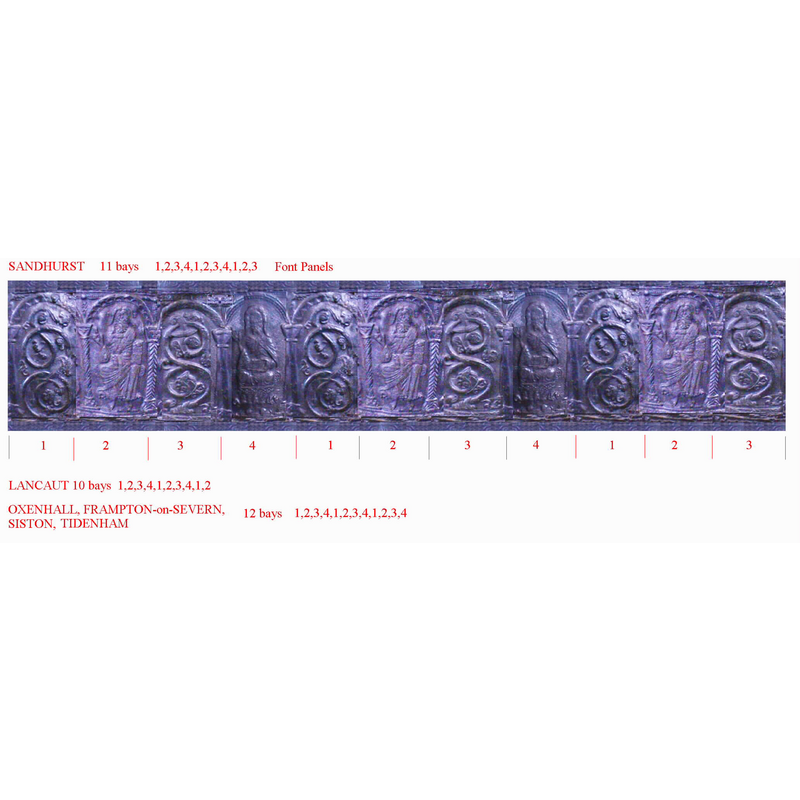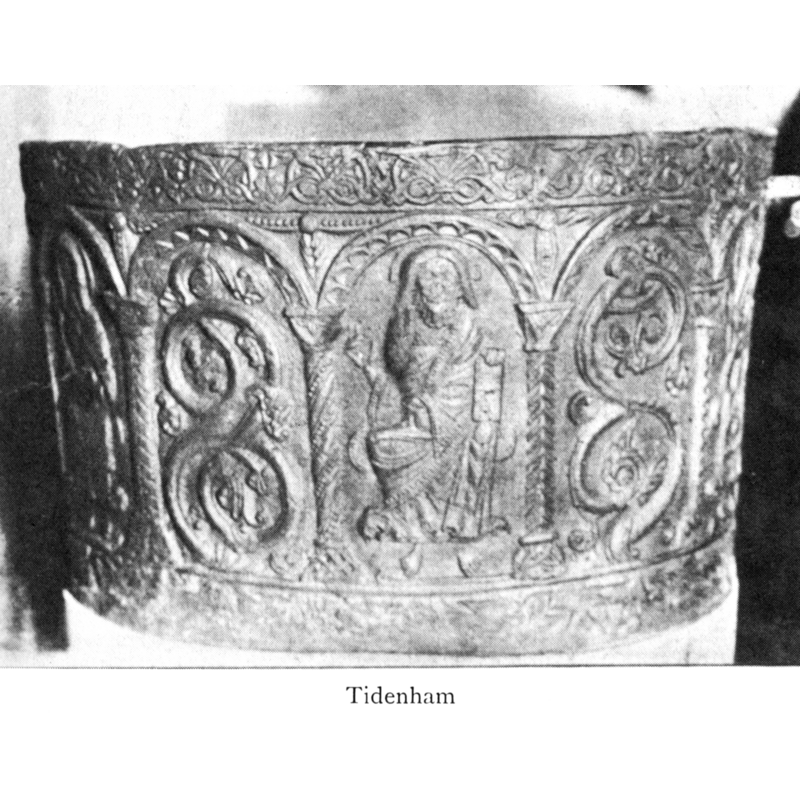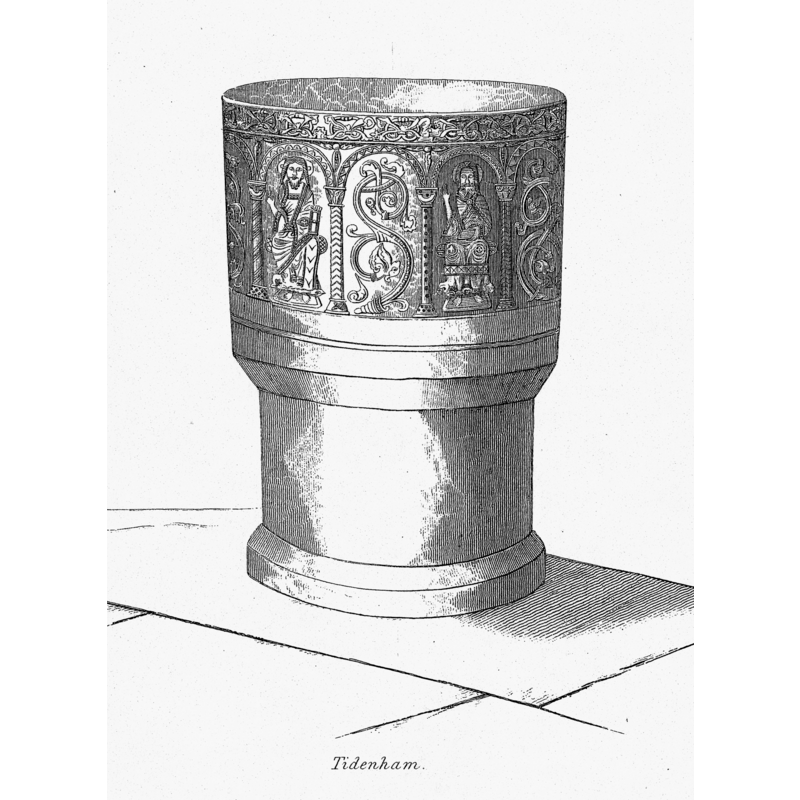Tidenham / Tedeham [Domesday] / Tedenham / Tideham
![Main image for Tidenham / Tedeham [Domesday] / Tedenham / Tideham](/static-50478a99ec6f36a15d6234548c59f63da52304e5/compressed/1080127012_compressed.png)
Image copyright © John Wilkes, 2008
Standing permission
Results: 8 records
view of base
view of basin
view of basin - projection
view of church exterior
view of font
view of font
view of font
INFORMATION
FontID: 00259TID
Object Type: Baptismal Font1
Church/Chapel: Parish Church of St. Mary and St. Peter
Church Patron Saints: St. Mary the Virgin & St. Peter
Church Location: Tidenham Ln, Tidenham, Gloucestershire NP16 7JQ, UK
Country Name: England
Location: Gloucestershire, South West
Directions to Site: Located on the W banks of the Severn, 3 km up the A48 (NE) from Chepstow
Ecclesiastic Region: Diocese of Gloucester
Historical Region: Hundred of Tidenham
Font Location in Church: Inside the church
Century and Period: 12th century [basin only], Medieval [composite]
Workshop/Group/Artisan: lead font
Cognate Fonts: Frampton-on-Severn, Siston, Oxenhall, Lancaut [i.e., Gloucester No. 1], and Sandhurst (Gloucs.), all said to have been made from the same mould
Credit and Acknowledgements: We are grateful to John Wilkes, of www.allthecotswolds.com, for the information on, and images of this font
Church Notes: a church here may have existed as early as the early 8thC
Font Notes:
Click to view
There are three entries for Tidenham [variant spellings] in the Domesday survey [https://opendomesday.org/place/ST5595/tidenham/] [accessed 11 February 2019] one of which reports a church in it. A font here is described and illustrated by Sarah Ormerod and J. Basire in Ormerod (1842), who suggests that the fonts from Tidenham and the one from Lancaut [for Lancaut font see Gloucester entry in this Index] are "apparently of the Saxon period, and certainly casts from the same mould. [...] The architecture may be referred either to the later Saxon, or earlier Norman period; but the dress, and, in particular, the beards of the figures, the decorations of the thrones, the ornamental foliage, and the scrolls, will more probably be referred to the Saxon æra. As far as their coarser execution will allow comparison, they very much resemble the delineations given in the Benedictional of Æthelwold." Paley (1844) notes this lead font and cites the earlier Archaeologia (vol. XXIX: 19) reference [i.e., Ormerod (1842)]. Listed in Cox (1875). In Andre (1882) simply as Norman. Lewis' Dictionary of 1848 notes: "the font is of lead, ancient, and curiously sculptured." Lethaby (1893) lists this one and the one from Lancaut as duplicates. "evidently of the twelfth century", and remarks on the similarity between this font and the one at Berneuil, in Somme, France. Listed in Cox & Harvey (1907) as a font "of Early Norman date, prior to 1100". Described and illustrated in Bond (1908) as a lead baptismal font believed to have been made from the same mould as the ones at Frampton-on-Severn, Siston, Oxenhall, Lancaut and Sandhurst, all in Gloucestershire. In Fryer (1908). [cf. Index entry for Frampton-on-Severn for more details, iconography, etc.] The entry for this parish in the Victoria County History (Gloucester, vol. 10, 1972) notes: "Of the church that stood on the site in the 11th century only the font survives [...] The church has a Norman lead font, one of six Gloucestershire fonts from the same blocks, another of them being made for the neighbouring church of Lancaut. The bowl is ornately decorated in relief with an arcade of 12 bays containing alternately figures and scroll-work; [...] the base is modern." Noted in Verey & Brooks (1999-2002). "Norton [i.e., John Norton, responsible for the 1857-8 restoration of the church] […] provided a new stone base for the late C12 circular lead font, one of six in the county cast from the same blocks […]" [NB: in a recent [27 January 2008] visit by John Wilkes to Tidenham the vicar showed him a stone pedestal which is not the one that appears under the lead basin in Basire's ca. 1842 drawing; nor does it match the basin illustrated in the same drawing for Lancaut]. The entry for this church in the CRSBI (2019) notes: "The church houses a lead font, one of six in Gloucestershire to be cast from the same mould. [...] The lead font is located in the nave almost opposite the S door and rests on a stone base provided by John Norton in 1858. The font is tub-shaped, with a slightly smaller bowl set inside with a drain hole. The bowls is decorated in relief with six seated male figures alternating with panels of foliated scrolls under an arcade of twelve arches. There are two different designs of scroll work: three panels feature an 'S' pattern and three have a reversed 'S' which is more intricate; both patterns are decorated with foliage. The four panels are repeated twice more in the same order to make up the twelve. The capitals and bases of the columns are triangular and the columns are decorated with chevrons, beaded spirals and small sunken pellet mouldings. There are strips of palmette decoration along the top and bottom of the arcades. Some cracks and small chips are visible around the rim, one particularly large on the W side of the font. There is white speckling on the lead more predominately on the W side, where the decoration is rather worn."
COORDINATES
Church Latitude & Longitude Decimal: 51.659212, -2.644719
Church Latitude & Longitude DMS: 51° 39′ 33.16″ N, 2° 38′ 40.99″ W
UTM: 30U 524575 5723196
MEDIUM AND MEASUREMENTS
Material: metal, lead
Font Shape: tub-shaped
Basin Interior Shape: round
Basin Exterior Shape: round
Diameter (inside rim): 63.75 cm* / 63 cm***
Diameter (includes rim): 80 cm** / 65 cm***
Basin Total Height: 55 cm* / 47.5 cm** / 38 cm***
Notes on Measurements: * [in inches in Fryer (1908: 281)] / **[Lethaby (1893) / *** CRSBI (2019)
REFERENCES
Victoria County History [online], University of London, 1993-. Accessed: 2012-07-25 00:00:00. URL: https://www.british-history.ac.uk.
André, J. Lewis, "Leaden Fonts in Sussex", 32, Surrey Archaeological Collections, relating to the history and antiquities of the county, 1882
Bond, Francis, Fonts and Font Covers, London: Waterstone, 1985 c1908
Corpus of Romanesque Sculpture in Britain and Ireland, The Corpus of Romanesque Sculpture in Britain and Ireland, The Corpus of Romanesque Sculpture in Britain and Ireland. Accessed: 2019-02-11 00:00:00. URL: http://www.crsbi.ac.uk.
Cox, John Charles, 1875-1877
Cox, John Charles, English Church Furniture, New York: E.P. Dutton & Co., 1907
Crossley, Frederick Herbert, English Church Craftsmanship: an Introduction to the Work of the Mediaval Period and Some Account of Later Developments, London: B.T. Batsford, 1941
Fryer, Alfred C., "The Gloucestershire fonts", 31(1908); 34(1911); 40(1917); 41(1918); 42(1920), Transactions of the Bristol and Gloucestershire Archaeological Society, 1908, 1911, 1920, pp. 31 (277-281); 34 (195-207); 40(39-56); 41 (27-35); 42 (69-88); p. 277-279, 281
Lethaby, William Richard, Leadwork, old and ornamental, and for the most part English [...] with illustrations, London; New York: Macmillan & co., 1893
Lewis, Samuel, A Topographical Dictionary of England, Comprising the Several Counties, Cities, Boroughs, Corporate and Market Towns, Parishes, Chapelries, and Townships, and the Islands of Guernsy, Jersey, and Man, with Historical and Statistical Descriptions [...], London: S. Lewis, 1831
Ormerod, George, "An account of some ancient remains [...] the leaden fonts of Llancaut and Tidenham [...]", XXIX, Archaeologia, 1842, pp. [18]-25; p. 19-25 and pl. III on p. 24
Paley, Frederick Apthorp, Illustrations of Baptismal Fonts, London, UK: John van Voorst, 1844
Verey, David, Gloucestershire, London: Penguin Books, 1999-2002
![[cf. FontNotes]](/static-50478a99ec6f36a15d6234548c59f63da52304e5/compressed/1080127013_compressed.png)




![the font at Tidenham shown together with the one [then] at Llancaut [Gloucester No. 1]](/static-50478a99ec6f36a15d6234548c59f63da52304e5/compressed/0060201001_compressed.png)
